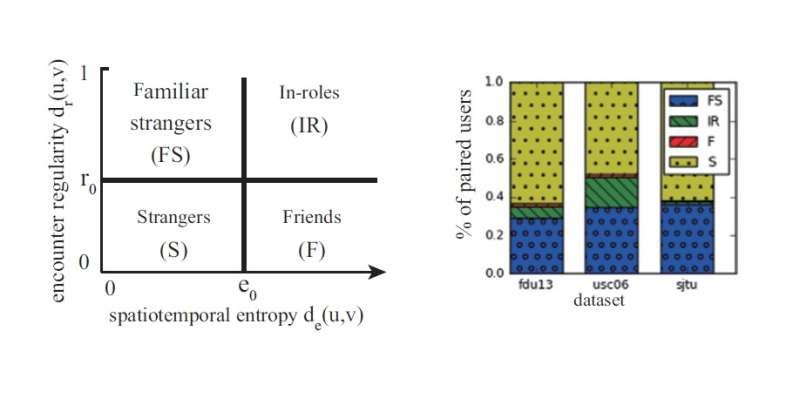December 9, 2016 feature
Encounters with 'familiar strangers' play overlooked role in human interactions

(Phys.org)—According to a new study, there are more familiar strangers in our lives than friends, coworkers, and all other acquaintances combined. Encounters with familiar strangers, defined as pairs of individuals who repeatedly encounter each other but have never been acquainted, has so far been overlooked in research on human networks. The new study finds that familiar strangers may play a significant role in processes such as information sharing and disease spreading.
The researchers, Di Liang, Xiang Li, and Yi-Qing Zhang, at Fudan University in Shanghai, China, have published a paper on their analysis of familiar strangers in a recent issue of EPL.
"This is the first work to identify familiar strangers from other human relationships and explore their special encounter patterns, which may inspire further studies on this common but overlooked relationship and its potential applications," Li told Phys.org.
Although researchers have known about the general concept of familiar strangers for several decades, no work has specifically investigated these encounters. Instead of being identified as such, familiar strangers are typically lumped together with general strangers and therefore regarded as "harmful noise."
The new study shows that this assumption is far from the truth. The researchers classified human relationships into four types: in-roles (who include colleagues, classmates, and others who we are acquainted with and see on a regular basis), friends (those who we are acquainted with, but do not see regularly), strangers (those who we are neither acquainted with nor see regularly), and familiar strangers (those who we see regularly but are not acquainted with).
By analyzing two Wi-Fi datasets and one dining hall data set from college campuses, the researchers classified all of the instances when two individuals were at the same place at the same time into one of the four types of human relationships.
They found that strangers made up the largest percentage of relationships, followed by familiar strangers. Both types of strangers greatly surpassed the percentage of social acquaintances, with in-roles being the third most common relationship type, followed by friends.
The researchers also found that, while the number of social relationships an individual can maintain is conventionally thought to be limited by the Dunbar number, which is 150, strangers and even familiar strangers do not face such a limit. The analysis shows that the number of familiar strangers an individual may encounter on a regular basis is much larger than the Dunbar number, and seems to be primarily affected by the behavioral patterns of the population as a whole.
As might be expected, encounters with familiar strangers tend to occur in a frequent and periodic manner, since they are often a result of individuals' daily or weekly routines briefly overlapping. This high regularity and stability of encounters with familiar strangers makes these encounters highly predictable, potentially providing a useful tool for predicting important nodes in networks with unknown topologies.
This ability could, in turn, help researchers predict the risk of disease epidemics, which could influence immunization strategies. Familiar strangers, in particular, could be prime targets for controlling the spread of contagious diseases.
"The encounters of familiar strangers are highly predictable, which may help to optimize robust network paths for information sharing," Li said. "Besides, given a reliable trust between familiar strangers, when assessing the 'risk' of an individual in disease spreading, it would be more accurate if we identify or predict his/her encounters with familiar strangers, instead of only considering the strong relationships, such as friends and co-workers. Therefore, we can design new target means on the generalization of an acquaintance immunization strategy against a pandemic."
In the future, the researchers plan to continue to improve the familiar stranger classifier performance and further investigate the potential applications, including human mobility prediction and information diffusion.
More information: Di Liang, Xiang Li, and Yi-Qing Zhang. "Identifying familiar strangers in human encounter networks." EPL. DOI: 10.1209/0295-5075/116/18006
Journal information: Europhysics Letters (EPL)
© 2016 Phys.org



















